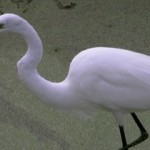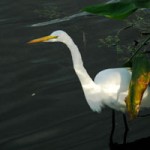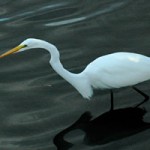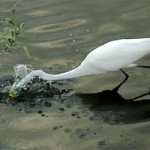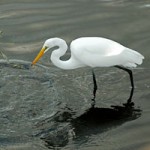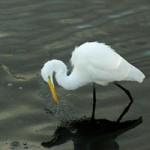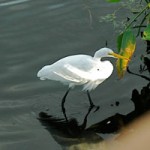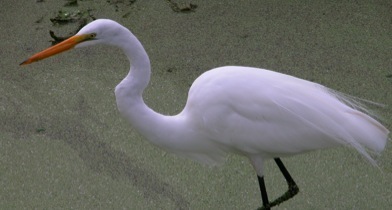
The Great Egret (Ardea alba) is the symbol of the Audubon Society. Hunted nearly to extinction in the 19th century for its plumes (aigrettes), the bird began a long, slow recovery once the Audubon Society formed and began to advocate saving the future of this incredible bird.One of the great blessings of modern technology is the ability, finally, to shoot digital photos with the speed of the old reliable film SLR–no more “point-and-wait” photography! Back in October of 2006, Marcella was able to capture this sequence of the Great Egret doing what it’s designed to do, with a camera doing what it’s designed to do: capture prey in a momentary burst of speed. The camera does this with its expensive computer technology and preprogrammed behavior. The bird relies on its preprogrammed behavior as well: it waits motionless, its long legs still, its long neck poised at a discreet distance until the time is right for that s-bent neck to straighten itself in a lightning-quick strike. Blink and you miss it. Good thing for us that Marcella (and her camera) didn’t blink.
Taxonomy
In North America, there are 4 species that have “egret” in their common name: the Great Egret (Ardea alba), the Snowy Egret (Egretta thula), the Reddish Egret (Egretta rufescens), and the Cattle Egret (Bubulcus ibis). As you can see, only 2 of them are even in the same genus. In fact, the Great Egret is more closely related to the Great Blue Heron (Ardea herodias) than it is to any of the other “egrets” in North America. For the record, there are 4 “herons” in North America as well, and 2 “night-herons”: Great Blue Heron, Little Blue Heron (Egretta caerulea), Tricolored Heron (Egretta tricolor), and Green Heron (Butorides virescens); Yellow-crowned Night-Heron and Black-crowned Night-Heron (the most widely distributed wading bird in the world) round out the heron/egret complex.
As you can see from the above taxonomorrhea, we call just as many North American Egretta species “herons” (4) as we do “egrets.”
Don’t even get me started on the confusion worldwide, with Purple Heron, Grey Heron, Goliath Heron, Large, Intermediate, and Little Egrets, the Reef-Herons and Pond Herons (note the hyphenation), etc.
Aigrettes
Aigrettes, according to Stevenson & Anderson (1994) are “modified feathers composed of a recurved shaft and long barbs with modified barbules that do not hook, thereby giving the feather a lacy appearance. Used for courtship displays, they are peculiar to Casmerodius [now Ardea], Egretta, and Bubulcus, appearing during the breeding season and shed later. They grow from the upper back and, in some species, from the crown and upper breast also” (60).
Interesting facts
The aigrettes grow only from the back of the Great Egret, and can reach 4-1/2 feet in length! According to Stevenson & Anderson, the Great Egret, “like the Great Blue Heron, swims well and will venture into deep water when fishes are concentrated there” (61). I guess the term “wading bird,” normally so apt, is in fact just a part-time job description!

